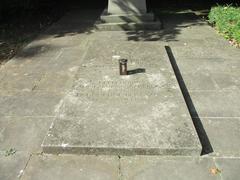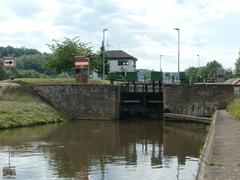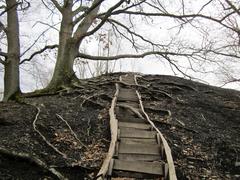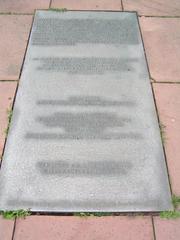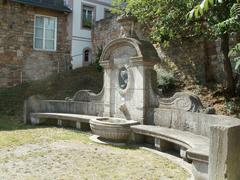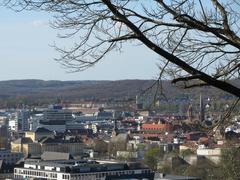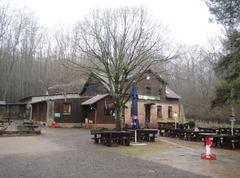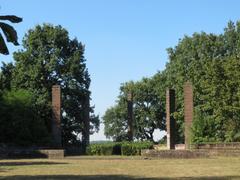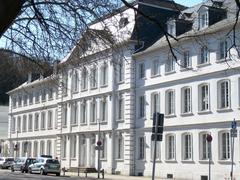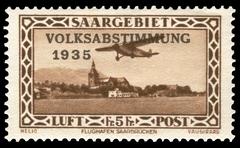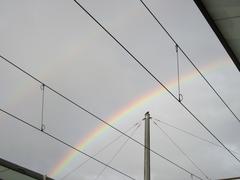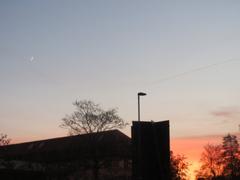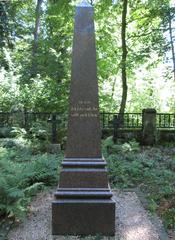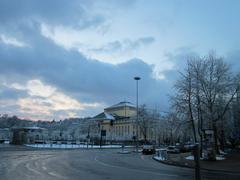
Saarbrücken Castle Visiting Hours, Tickets, and Historical Sites Guide
Date: 04/07/2025
Introduction: A Landmark of Saarland’s Heritage
Saarbrücken Castle (Schloss Saarbrücken) is more than just a historical building—it is a living monument to the Saarland region’s layered past and vibrant present. Overlooking the Saar River, the castle’s story stretches back more than a millennium, transitioning from a Celtic refuge and Roman settlement to a medieval fortress, a Baroque palace, and, most recently, a hub for culture and government. Its evolution mirrors the shifting tides of European history and the enduring spirit of the city it anchors (saarbruecken.de; Wikipedia; thecrazytourist.com; Germany Travel).
A visit to Saarbrücken Castle is a journey through time, revealing architectural marvels, sweeping courtyards, immersive museum exhibits, and spaces that invite reflection on both tragedy and triumph. This guide covers everything you need to know: history, architectural highlights, visiting hours, tickets, accessibility, travel tips, and nearby attractions.
Table of Contents
- Introduction
- Early Origins and Strategic Importance
- Medieval and Renaissance Development
- Baroque Transformation: The Stengel Era
- Modern Renovations and Contemporary Use
- Architectural Highlights and Archaeological Discoveries
- Visiting Hours and Ticket Information
- Accessibility and Visitor Tips
- Guided Tours and Special Events
- Gardens, Views, and Photo Opportunities
- Nearby Attractions and Sample Itinerary
- Frequently Asked Questions (FAQ)
- Conclusion and How to Stay Updated
Early Origins and Strategic Importance
The site of Saarbrücken Castle has held strategic significance since ancient times. Archaeological finds attest to Celtic settlements and a Roman vicus, with the area’s favorable river crossing and proximity to key trading routes making it a coveted seat of power (saarbruecken.de).
The first recorded mention of a castle here dates to 999 CE, when Emperor Otto III granted the “sarabruca” fortress to the Bishop of Metz. Over the following centuries, the castle became a vital defensive stronghold and a symbol of regional authority, protecting the river crossing and controlling the surrounding wetlands (saarbruecken.de).
Medieval and Renaissance Development
Throughout the Middle Ages, the castle was expanded and re-fortified to reflect the growing influence of its rulers, becoming the seat of the Counts of Saarbrücken. By the late 15th century, the complex included defensive towers, a chapel (later the Schlosskirche), and underground chambers—some of which still survive and are open to visitors (thecrazytourist.com). The castle was repeatedly damaged and rebuilt, especially during the 12th and 17th centuries, highlighting its importance in regional conflicts (Live the World).
Baroque Transformation: The Stengel Era
The most significant change occurred in the 18th century. Prince William Henry of Nassau-Saarbrücken commissioned the renowned architect Friedrich Joachim Stengel to transform the medieval fortress into a Baroque palace. Between 1738 and 1748, Stengel’s vision reshaped the city center, creating a harmonious ensemble that included the castle, Schlossplatz, Ludwigsplatz, and St. Johanner Markt (Germany Travel). The new palace featured symmetrical wings, ornate facades, and grand interiors, establishing Saarbrücken as a center of Baroque culture (saarbruecken.de).
Modern Renovations and Contemporary Use
The 19th and 20th centuries were marked by industrialization, war, and major architectural interventions. Saarbrücken Castle was damaged during the World Wars but was restored and adapted for modern use. In 1989, architect Gottfried Böhm added a bold glass and steel wing, forming a striking contrast with the Baroque structure and symbolizing the castle’s bridging of past and present (Guide to Europe). Today, the castle houses government offices, the Saar Historical Museum, and serves as a venue for events and cultural programming (Saarbrücken Tourism).
Architectural Highlights and Archaeological Discoveries
- Baroque Palace: Stengel’s design features a U-shaped plan, grand staircase, and decorative stucco and pilasters. The Schlosskirche, originally Gothic, was reworked in the Baroque style and houses the tombs of the Nassau-Saarbrücken dynasty.
- Modern Glass Wing: Böhm’s intervention introduces transparency and light, with panoramic views and a dialogue between old and new.
- Medieval Vaults and Casemates: Below the palace, visitors can explore subterranean chambers, medieval cellars, and interactive archaeological exhibits. Some spaces are illuminated with UV light to reveal ancient masonry (thecrazytourist.com; Germany Travel).
Visiting Hours and Ticket Information
- Opening Hours: Tuesday to Sunday, 10:00 AM – 6:00 PM (last admission 5:30 PM). Closed on Mondays and select holidays. Always check the official website for current times.
- Tickets: Adults €7, reduced €5 (students/seniors), children under 12 free. Family and group rates available. Courtyard and gardens are free; museum and guided tour tickets can be purchased online or onsite.
- Guided Tours: Available in German and English, typically 60–90 minutes. Advance booking recommended during peak seasons (delveintoeurope.com).
Accessibility and Visitor Tips
- Accessibility: Modernized areas include ramps and elevators; most public zones are accessible to wheelchair users. Some underground sections have limited access—contact the castle for details.
- Getting There: Centrally located at Schlossplatz, accessible by tram, bus, and on foot from the city center. Paid parking is nearby, but spaces can be limited during events.
- Facilities: Visitor center, restrooms, on-site café, and gift shop. Service animals are welcome.
Guided Tours and Special Events
The castle hosts concerts, exhibitions, and seasonal markets, including a popular Christmas market. Guided tours reveal stories from the Baroque era to WWII, and special events animate the courtyard and gardens throughout the year (Saarbrücken Tourism; delveintoeurope.com).
Gardens, Views, and Photo Opportunities
- Hieronymus Bock Herb Garden: Below the southern side, this peaceful space is ideal for a break or a stroll among medicinal and culinary herbs.
- Panoramic Views: The castle’s terraces and ramparts offer stunning vistas of the Saar River and cityscape—best captured in early morning or late afternoon light.
- Photography: The Baroque facade, modern glass wing, gardens, and courtyard provide excellent photo backdrops.
Nearby Attractions and Sample Itinerary
Combine your visit with other Saarbrücken historical sites:
- Ludwigskirche: A Baroque masterpiece nearby.
- St. Johanner Markt: Lively market square with cafes and shops.
- Old Bridge (Alte Brücke): Scenic riverside walks with castle views.
Sample Day: Start at the castle (museum and casemates), stroll Schlossplatz, lunch at St. Johanner Markt, visit Ludwigskirche, and end with a riverside walk.
Frequently Asked Questions (FAQ)
Q: What are the castle’s visiting hours?
A: Tuesday–Sunday, 10:00 AM–6:00 PM; closed Mondays. Always confirm ahead of your visit.
Q: How much do tickets cost?
A: €7 adults, €5 reduced, children under 12 free. Museum and tour tickets available online or onsite.
Q: Are guided tours available in English?
A: Yes, and advance booking is suggested.
Q: Is the castle wheelchair accessible?
A: Most areas are, but some historic underground sections are not.
Q: Where can I park?
A: Paid parking at Schlossplatz and nearby garages.
Q: Are there family-friendly activities?
A: Yes—gardens, interactive museum exhibits, and open spaces are great for families.
Conclusion and Staying Updated
Saarbrücken Castle is a vivid symbol of the region’s resilience, creativity, and cultural richness—offering visitors the chance to journey through centuries within a single day. Its central location, layered architecture, and dynamic programming make it essential for anyone exploring Saarbrücken or the greater Saarland area.
For the best experience, check the latest visiting hours and ticket details on the official tourism website, book a guided tour, and download the Audiala app for audio guides, event updates, and exclusive content. Follow Saarbrücken Tourism for news on upcoming events and exhibitions.
Sources
- Saarbruecken.de – Saarbrücken Castle History
- TheCrazyTourist – Saarbrücken Castle Overview
- Germany Travel – Saarbrücken Castle and Baroque Architecture
- Guide to Europe – Saarbrücken Castle Details
- Delve into Europe – Saarbrücken Castle Visitor Information
- Saarbrücken Tourism – History and Visitor Guide
- Live the World – Saarbrücken Castle Cultural Context
Image suggestions (to be added by publisher):
- Saarbrücken Castle exterior: Baroque wings with modern glass facade (alt: “Saarbrücken Castle with Baroque and modern architecture”)
- Panoramic view from castle terraces over the Saar River (alt: “Panoramic Saarbrücken city and river view from castle terraces”)
- Medieval vaults and casemates with UV lighting (alt: “Subterranean medieval cellars beneath Saarbrücken Castle”)
- Courtyard during summer event (alt: “Open-air concert in Saarbrücken Castle courtyard”)
For further exploration, read our guides to Ludwigskirche: Saarbrücken’s Baroque Masterpiece and Old Saarbrücken: A Historical Walking Tour.










































